FIN200 Trimester 2 2018 Project Report: Corporate Finance Analysis
VerifiedAdded on 2023/06/04
|12
|2742
|285
Report
AI Summary
This report provides a comprehensive analysis of key concepts in corporate finance, including the Security Market Line (SML) and Capital Market Line (CML), comparing their graphical representations and underlying principles. It explores the significance of minimum variance portfolios in risk management and portfolio optimization, detailing their methodology and limitations. Furthermore, the report delves into the Capital Asset Pricing Model (CAPM) equation, explaining its relevance in calculating the required rate of return and its practical applications for financial analysts and investors. The analysis highlights the importance of these tools in making informed investment decisions and managing financial risks, providing a strong foundation for understanding corporate finance principles. The report also includes graphical representations and calculations to illustrate the concepts, enhancing the understanding of the readers. The report concludes by emphasizing the practical utility of these tools for financial professionals and investors, reinforcing the significance of their application in the real-world financial environment.

Running Head: Corporate Finance
1
Project Report: Corporate Finance
1
Project Report: Corporate Finance
Paraphrase This Document
Need a fresh take? Get an instant paraphrase of this document with our AI Paraphraser
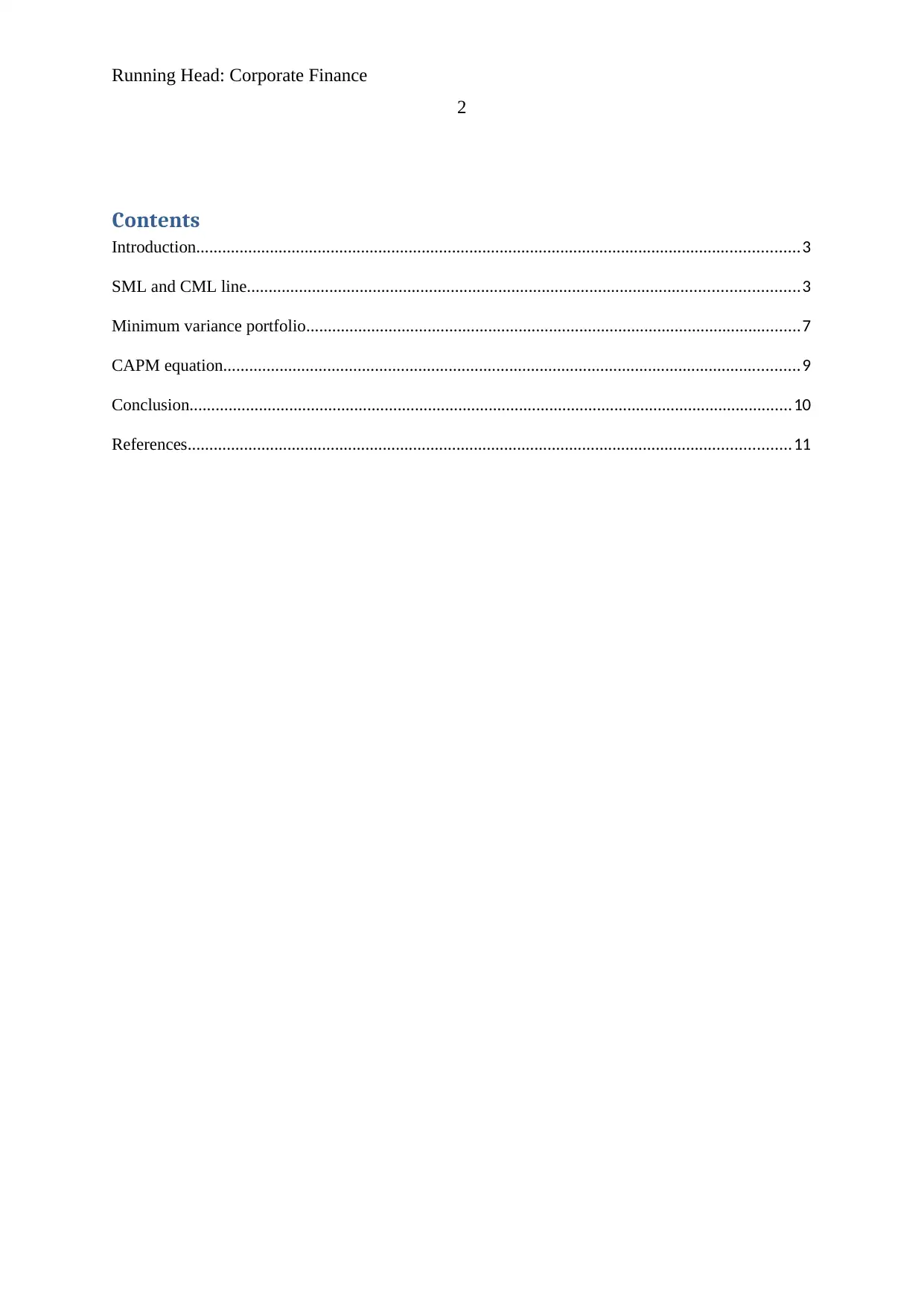
Running Head: Corporate Finance
2
Contents
Introduction...........................................................................................................................................3
SML and CML line...............................................................................................................................3
Minimum variance portfolio..................................................................................................................7
CAPM equation.....................................................................................................................................9
Conclusion...........................................................................................................................................10
References...........................................................................................................................................11
2
Contents
Introduction...........................................................................................................................................3
SML and CML line...............................................................................................................................3
Minimum variance portfolio..................................................................................................................7
CAPM equation.....................................................................................................................................9
Conclusion...........................................................................................................................................10
References...........................................................................................................................................11

Running Head: Corporate Finance
3
Introduction:
Identifying the nature of the different corporate financial tools is crucial for the
financial analyst, financial managers and the investors. The different tools take the concern
on the different aspects of an investment and offer different result. It is necessary for the
related parties to identify the necessity and choose the better method accordingly. Such as,
minimum variance portfolio method is better when an investor wants to get lower risk, no
matter what would be the return from the investment. As well, the SML line is used to
represent the related risk position and return on the basis of risk. CAPM method is helpful for
the business and the investors to identify the expected rate of return from the business
(Damodaran, 2011).
In the report, the SML line, CML line, CAPM model and minimum variance portfolio
has been studied and it has been recognized that how an organization could identify the
different investment position of a stock with the help of these tools.
SML and CML line:
Security market line (SML) represents the result of CAPM equation in a graphical
manner. It basically represents the relations among the expected return of the stock and risk
of the stock which is represented in the beta factors. In different words, it could be said that
the security market line of a portfolio and stock represents the expected return which could be
expected from a particular stock or the portfolio against the different beta factors of that stock
or portfolio (Lee and Lee, 2006). The security line is basically based on the equation of
CAPM which is as follows:
E(Ri) = RF + βi × (E(RM) - RF)
The graphical representation of SML line has been presented on the basis of the below
case:
Beta Security
Market
Line: ri
Risk-
Free
Rate
Market
Return
0 5.00% 5% 8%
0.5 6.50% 5% 8%
3
Introduction:
Identifying the nature of the different corporate financial tools is crucial for the
financial analyst, financial managers and the investors. The different tools take the concern
on the different aspects of an investment and offer different result. It is necessary for the
related parties to identify the necessity and choose the better method accordingly. Such as,
minimum variance portfolio method is better when an investor wants to get lower risk, no
matter what would be the return from the investment. As well, the SML line is used to
represent the related risk position and return on the basis of risk. CAPM method is helpful for
the business and the investors to identify the expected rate of return from the business
(Damodaran, 2011).
In the report, the SML line, CML line, CAPM model and minimum variance portfolio
has been studied and it has been recognized that how an organization could identify the
different investment position of a stock with the help of these tools.
SML and CML line:
Security market line (SML) represents the result of CAPM equation in a graphical
manner. It basically represents the relations among the expected return of the stock and risk
of the stock which is represented in the beta factors. In different words, it could be said that
the security market line of a portfolio and stock represents the expected return which could be
expected from a particular stock or the portfolio against the different beta factors of that stock
or portfolio (Lee and Lee, 2006). The security line is basically based on the equation of
CAPM which is as follows:
E(Ri) = RF + βi × (E(RM) - RF)
The graphical representation of SML line has been presented on the basis of the below
case:
Beta Security
Market
Line: ri
Risk-
Free
Rate
Market
Return
0 5.00% 5% 8%
0.5 6.50% 5% 8%
⊘ This is a preview!⊘
Do you want full access?
Subscribe today to unlock all pages.

Trusted by 1+ million students worldwide
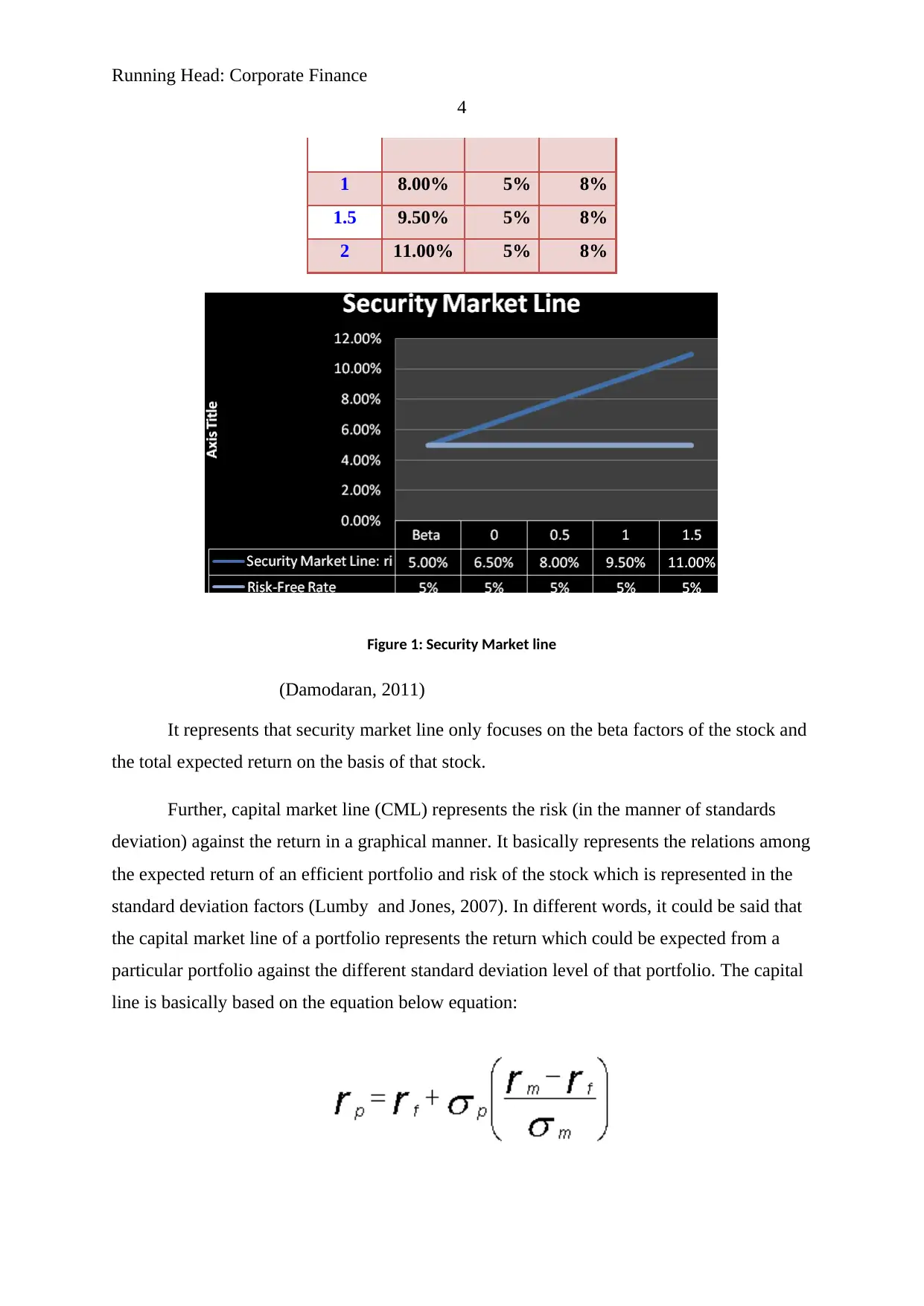
Running Head: Corporate Finance
4
1 8.00% 5% 8%
1.5 9.50% 5% 8%
2 11.00% 5% 8%
Figure 1: Security Market line
(Damodaran, 2011)
It represents that security market line only focuses on the beta factors of the stock and
the total expected return on the basis of that stock.
Further, capital market line (CML) represents the risk (in the manner of standards
deviation) against the return in a graphical manner. It basically represents the relations among
the expected return of an efficient portfolio and risk of the stock which is represented in the
standard deviation factors (Lumby and Jones, 2007). In different words, it could be said that
the capital market line of a portfolio represents the return which could be expected from a
particular portfolio against the different standard deviation level of that portfolio. The capital
line is basically based on the equation below equation:
4
1 8.00% 5% 8%
1.5 9.50% 5% 8%
2 11.00% 5% 8%
Figure 1: Security Market line
(Damodaran, 2011)
It represents that security market line only focuses on the beta factors of the stock and
the total expected return on the basis of that stock.
Further, capital market line (CML) represents the risk (in the manner of standards
deviation) against the return in a graphical manner. It basically represents the relations among
the expected return of an efficient portfolio and risk of the stock which is represented in the
standard deviation factors (Lumby and Jones, 2007). In different words, it could be said that
the capital market line of a portfolio represents the return which could be expected from a
particular portfolio against the different standard deviation level of that portfolio. The capital
line is basically based on the equation below equation:
Paraphrase This Document
Need a fresh take? Get an instant paraphrase of this document with our AI Paraphraser

Running Head: Corporate Finance
5
(Lumby and Jones, 2007)
The graphical representation of CML line has been presented on the basis of the
below case:
capital market line
risk return
0.00% 6.00%
4.00% 9.16%
8.00% 12.32%
12.00% 15.48%
16.00% 18.64%
20.00% 21.80%
24.00% 24.96%
28.00% 28.13%
32.00% 31.29%
36.00% 34.45%
40.00% 37.61%
44.00% 40.77%
48.00% 43.93%
52.00% 47.09%
56.00% 50.25%
60.00% 53.41%
64.00% 56.57%
68.00% 59.73%
5
(Lumby and Jones, 2007)
The graphical representation of CML line has been presented on the basis of the
below case:
capital market line
risk return
0.00% 6.00%
4.00% 9.16%
8.00% 12.32%
12.00% 15.48%
16.00% 18.64%
20.00% 21.80%
24.00% 24.96%
28.00% 28.13%
32.00% 31.29%
36.00% 34.45%
40.00% 37.61%
44.00% 40.77%
48.00% 43.93%
52.00% 47.09%
56.00% 50.25%
60.00% 53.41%
64.00% 56.57%
68.00% 59.73%
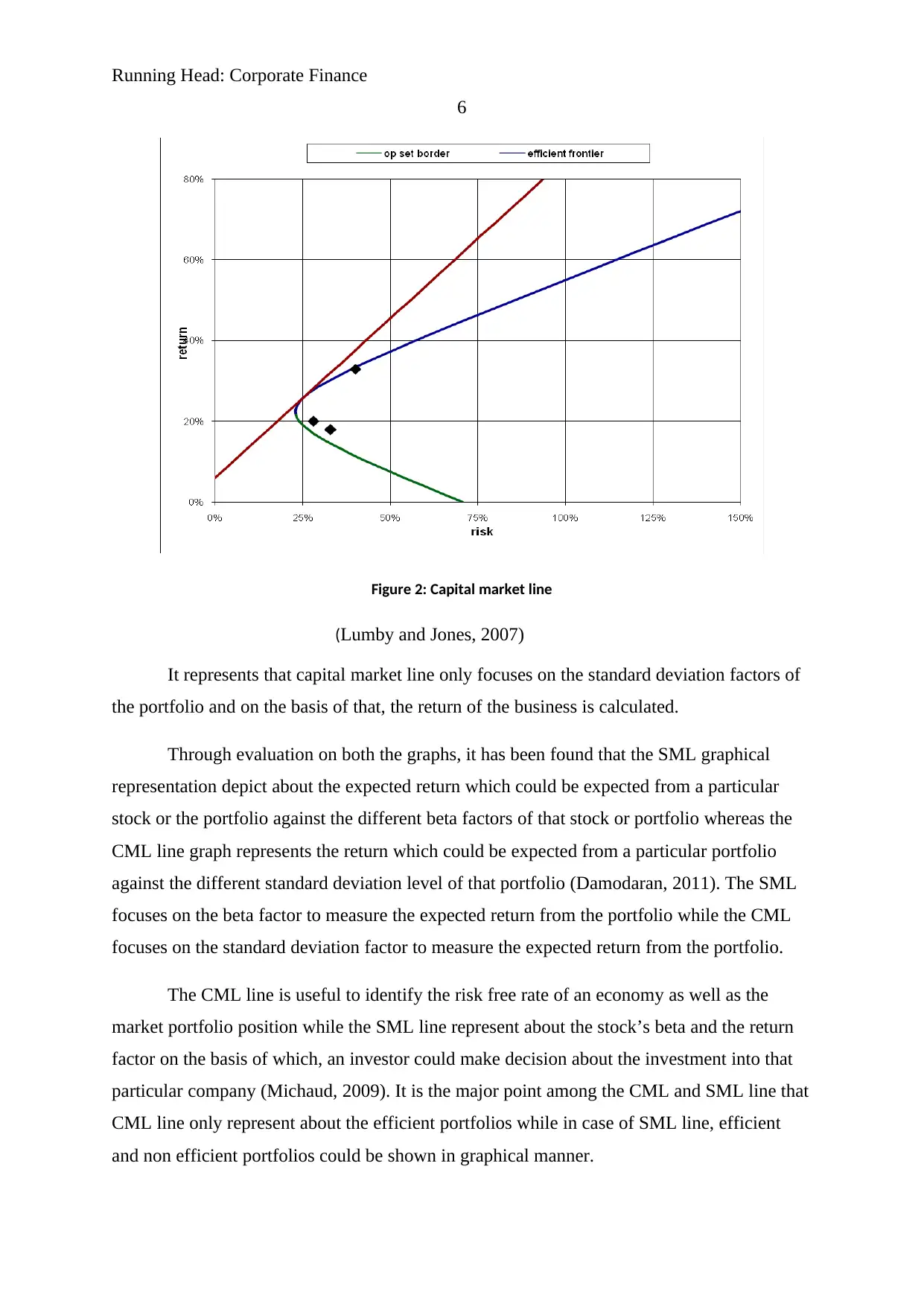
Running Head: Corporate Finance
6
Figure 2: Capital market line
(Lumby and Jones, 2007)
It represents that capital market line only focuses on the standard deviation factors of
the portfolio and on the basis of that, the return of the business is calculated.
Through evaluation on both the graphs, it has been found that the SML graphical
representation depict about the expected return which could be expected from a particular
stock or the portfolio against the different beta factors of that stock or portfolio whereas the
CML line graph represents the return which could be expected from a particular portfolio
against the different standard deviation level of that portfolio (Damodaran, 2011). The SML
focuses on the beta factor to measure the expected return from the portfolio while the CML
focuses on the standard deviation factor to measure the expected return from the portfolio.
The CML line is useful to identify the risk free rate of an economy as well as the
market portfolio position while the SML line represent about the stock’s beta and the return
factor on the basis of which, an investor could make decision about the investment into that
particular company (Michaud, 2009). It is the major point among the CML and SML line that
CML line only represent about the efficient portfolios while in case of SML line, efficient
and non efficient portfolios could be shown in graphical manner.
6
Figure 2: Capital market line
(Lumby and Jones, 2007)
It represents that capital market line only focuses on the standard deviation factors of
the portfolio and on the basis of that, the return of the business is calculated.
Through evaluation on both the graphs, it has been found that the SML graphical
representation depict about the expected return which could be expected from a particular
stock or the portfolio against the different beta factors of that stock or portfolio whereas the
CML line graph represents the return which could be expected from a particular portfolio
against the different standard deviation level of that portfolio (Damodaran, 2011). The SML
focuses on the beta factor to measure the expected return from the portfolio while the CML
focuses on the standard deviation factor to measure the expected return from the portfolio.
The CML line is useful to identify the risk free rate of an economy as well as the
market portfolio position while the SML line represent about the stock’s beta and the return
factor on the basis of which, an investor could make decision about the investment into that
particular company (Michaud, 2009). It is the major point among the CML and SML line that
CML line only represent about the efficient portfolios while in case of SML line, efficient
and non efficient portfolios could be shown in graphical manner.
⊘ This is a preview!⊘
Do you want full access?
Subscribe today to unlock all pages.

Trusted by 1+ million students worldwide
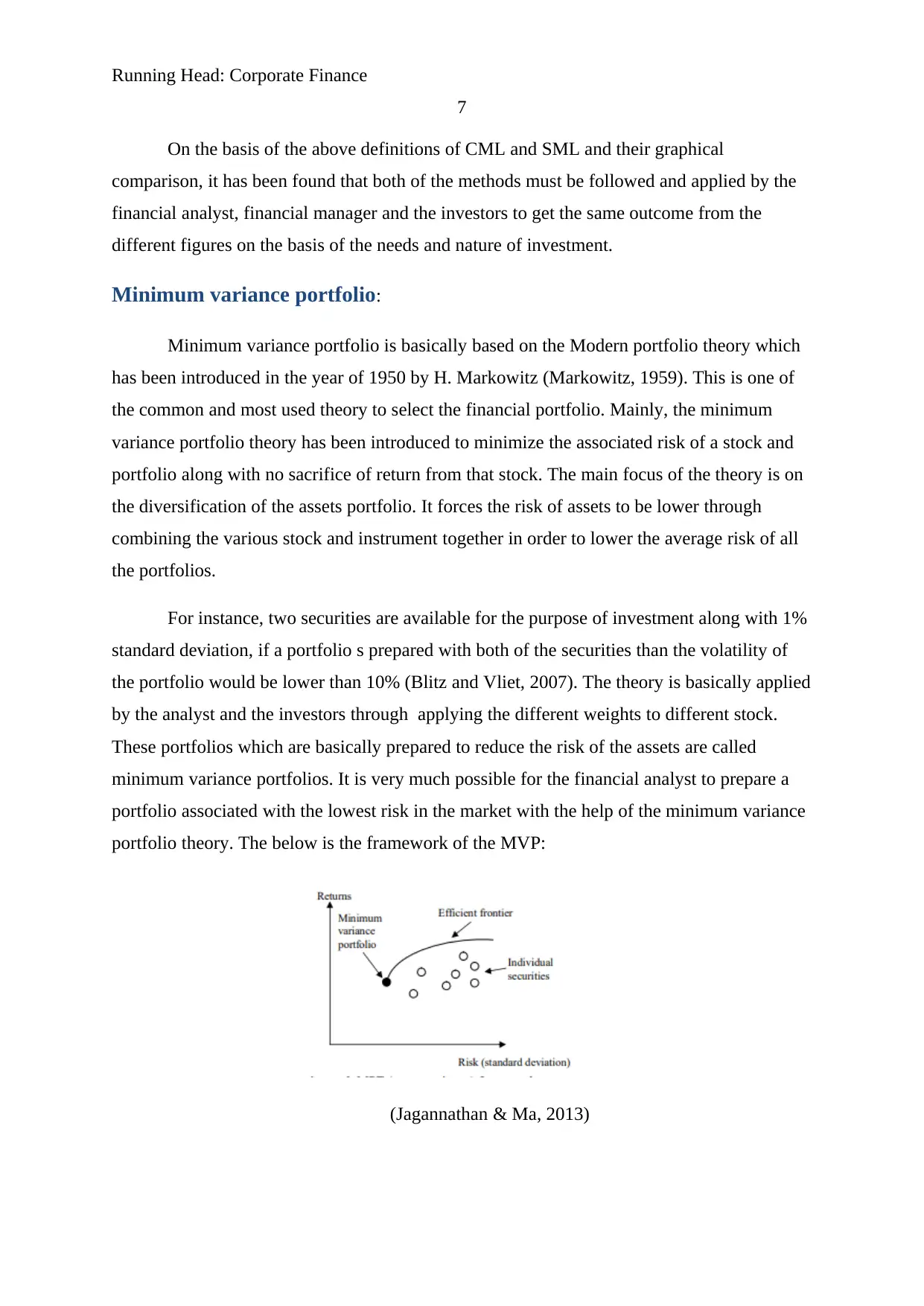
Running Head: Corporate Finance
7
On the basis of the above definitions of CML and SML and their graphical
comparison, it has been found that both of the methods must be followed and applied by the
financial analyst, financial manager and the investors to get the same outcome from the
different figures on the basis of the needs and nature of investment.
Minimum variance portfolio:
Minimum variance portfolio is basically based on the Modern portfolio theory which
has been introduced in the year of 1950 by H. Markowitz (Markowitz, 1959). This is one of
the common and most used theory to select the financial portfolio. Mainly, the minimum
variance portfolio theory has been introduced to minimize the associated risk of a stock and
portfolio along with no sacrifice of return from that stock. The main focus of the theory is on
the diversification of the assets portfolio. It forces the risk of assets to be lower through
combining the various stock and instrument together in order to lower the average risk of all
the portfolios.
For instance, two securities are available for the purpose of investment along with 1%
standard deviation, if a portfolio s prepared with both of the securities than the volatility of
the portfolio would be lower than 10% (Blitz and Vliet, 2007). The theory is basically applied
by the analyst and the investors through applying the different weights to different stock.
These portfolios which are basically prepared to reduce the risk of the assets are called
minimum variance portfolios. It is very much possible for the financial analyst to prepare a
portfolio associated with the lowest risk in the market with the help of the minimum variance
portfolio theory. The below is the framework of the MVP:
(Jagannathan & Ma, 2013)
7
On the basis of the above definitions of CML and SML and their graphical
comparison, it has been found that both of the methods must be followed and applied by the
financial analyst, financial manager and the investors to get the same outcome from the
different figures on the basis of the needs and nature of investment.
Minimum variance portfolio:
Minimum variance portfolio is basically based on the Modern portfolio theory which
has been introduced in the year of 1950 by H. Markowitz (Markowitz, 1959). This is one of
the common and most used theory to select the financial portfolio. Mainly, the minimum
variance portfolio theory has been introduced to minimize the associated risk of a stock and
portfolio along with no sacrifice of return from that stock. The main focus of the theory is on
the diversification of the assets portfolio. It forces the risk of assets to be lower through
combining the various stock and instrument together in order to lower the average risk of all
the portfolios.
For instance, two securities are available for the purpose of investment along with 1%
standard deviation, if a portfolio s prepared with both of the securities than the volatility of
the portfolio would be lower than 10% (Blitz and Vliet, 2007). The theory is basically applied
by the analyst and the investors through applying the different weights to different stock.
These portfolios which are basically prepared to reduce the risk of the assets are called
minimum variance portfolios. It is very much possible for the financial analyst to prepare a
portfolio associated with the lowest risk in the market with the help of the minimum variance
portfolio theory. The below is the framework of the MVP:
(Jagannathan & Ma, 2013)
Paraphrase This Document
Need a fresh take? Get an instant paraphrase of this document with our AI Paraphraser
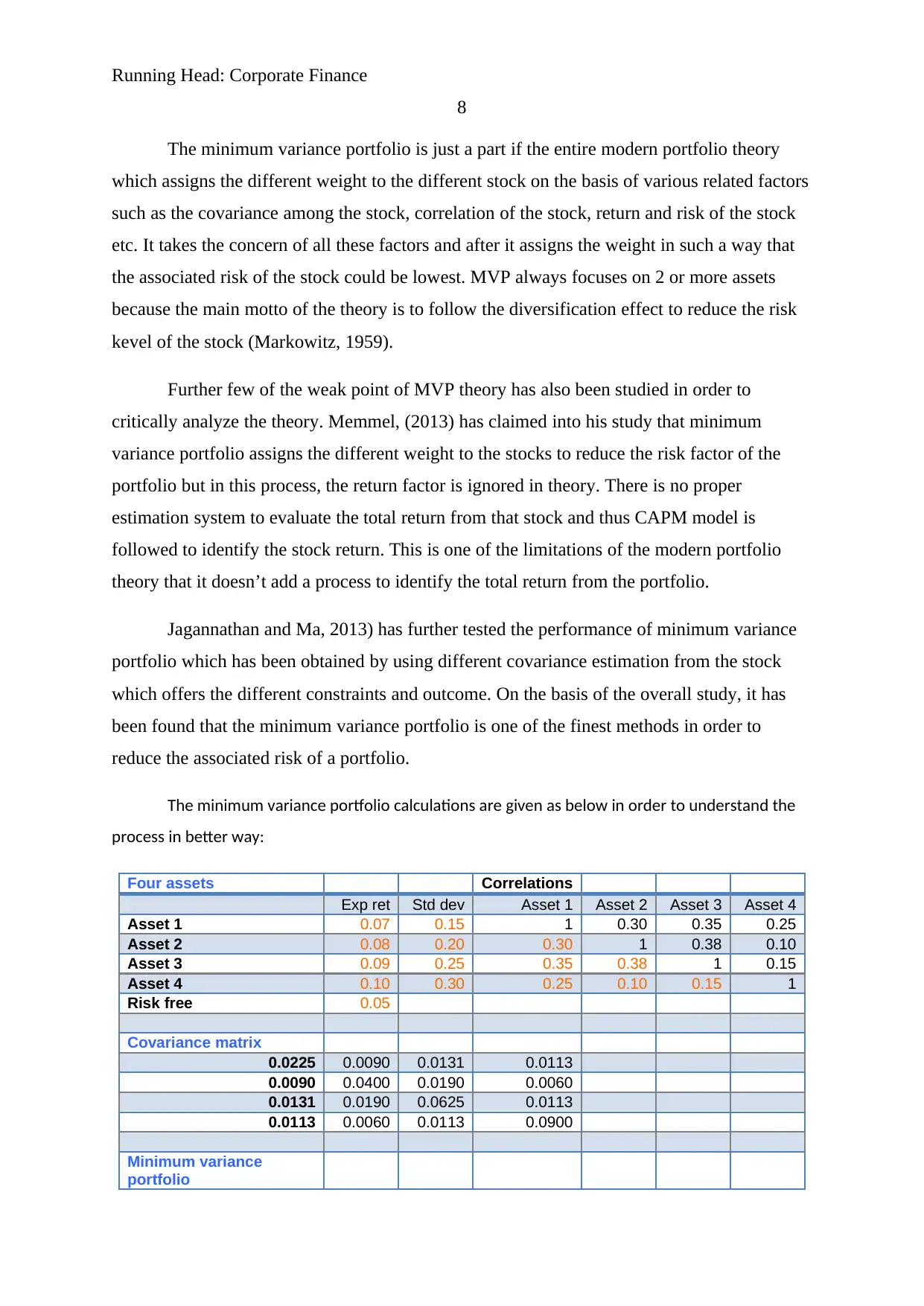
Running Head: Corporate Finance
8
The minimum variance portfolio is just a part if the entire modern portfolio theory
which assigns the different weight to the different stock on the basis of various related factors
such as the covariance among the stock, correlation of the stock, return and risk of the stock
etc. It takes the concern of all these factors and after it assigns the weight in such a way that
the associated risk of the stock could be lowest. MVP always focuses on 2 or more assets
because the main motto of the theory is to follow the diversification effect to reduce the risk
kevel of the stock (Markowitz, 1959).
Further few of the weak point of MVP theory has also been studied in order to
critically analyze the theory. Memmel, (2013) has claimed into his study that minimum
variance portfolio assigns the different weight to the stocks to reduce the risk factor of the
portfolio but in this process, the return factor is ignored in theory. There is no proper
estimation system to evaluate the total return from that stock and thus CAPM model is
followed to identify the stock return. This is one of the limitations of the modern portfolio
theory that it doesn’t add a process to identify the total return from the portfolio.
Jagannathan and Ma, 2013) has further tested the performance of minimum variance
portfolio which has been obtained by using different covariance estimation from the stock
which offers the different constraints and outcome. On the basis of the overall study, it has
been found that the minimum variance portfolio is one of the finest methods in order to
reduce the associated risk of a portfolio.
The minimum variance portfolio calculations are given as below in order to understand the
process in better way:
Four assets Correlations
Exp ret Std dev Asset 1 Asset 2 Asset 3 Asset 4
Asset 1 0.07 0.15 1 0.30 0.35 0.25
Asset 2 0.08 0.20 0.30 1 0.38 0.10
Asset 3 0.09 0.25 0.35 0.38 1 0.15
Asset 4 0.10 0.30 0.25 0.10 0.15 1
Risk free 0.05
Covariance matrix
0.0225 0.0090 0.0131 0.0113
0.0090 0.0400 0.0190 0.0060
0.0131 0.0190 0.0625 0.0113
0.0113 0.0060 0.0113 0.0900
Minimum variance
portfolio
8
The minimum variance portfolio is just a part if the entire modern portfolio theory
which assigns the different weight to the different stock on the basis of various related factors
such as the covariance among the stock, correlation of the stock, return and risk of the stock
etc. It takes the concern of all these factors and after it assigns the weight in such a way that
the associated risk of the stock could be lowest. MVP always focuses on 2 or more assets
because the main motto of the theory is to follow the diversification effect to reduce the risk
kevel of the stock (Markowitz, 1959).
Further few of the weak point of MVP theory has also been studied in order to
critically analyze the theory. Memmel, (2013) has claimed into his study that minimum
variance portfolio assigns the different weight to the stocks to reduce the risk factor of the
portfolio but in this process, the return factor is ignored in theory. There is no proper
estimation system to evaluate the total return from that stock and thus CAPM model is
followed to identify the stock return. This is one of the limitations of the modern portfolio
theory that it doesn’t add a process to identify the total return from the portfolio.
Jagannathan and Ma, 2013) has further tested the performance of minimum variance
portfolio which has been obtained by using different covariance estimation from the stock
which offers the different constraints and outcome. On the basis of the overall study, it has
been found that the minimum variance portfolio is one of the finest methods in order to
reduce the associated risk of a portfolio.
The minimum variance portfolio calculations are given as below in order to understand the
process in better way:
Four assets Correlations
Exp ret Std dev Asset 1 Asset 2 Asset 3 Asset 4
Asset 1 0.07 0.15 1 0.30 0.35 0.25
Asset 2 0.08 0.20 0.30 1 0.38 0.10
Asset 3 0.09 0.25 0.35 0.38 1 0.15
Asset 4 0.10 0.30 0.25 0.10 0.15 1
Risk free 0.05
Covariance matrix
0.0225 0.0090 0.0131 0.0113
0.0090 0.0400 0.0190 0.0060
0.0131 0.0190 0.0625 0.0113
0.0113 0.0060 0.0113 0.0900
Minimum variance
portfolio
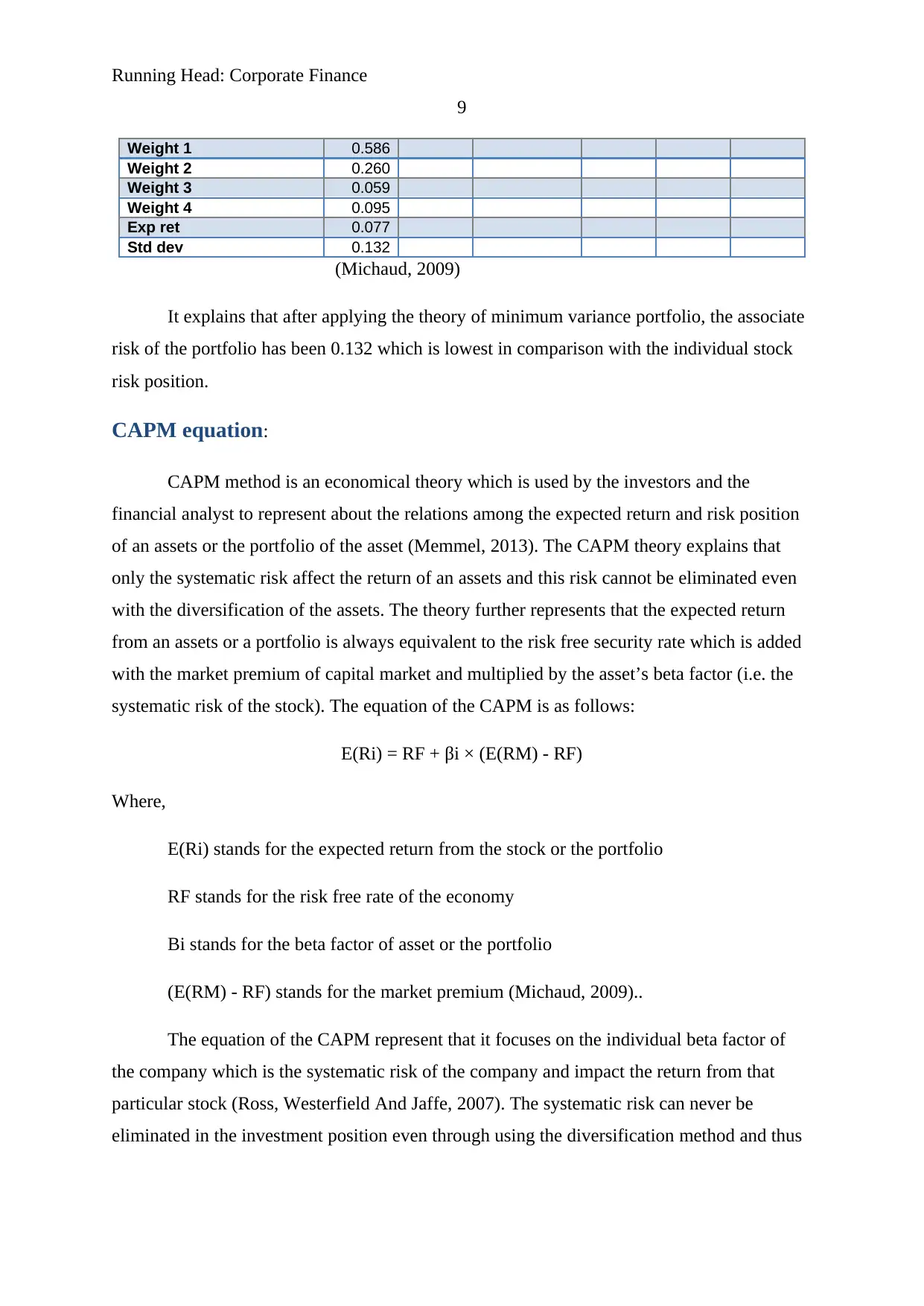
Running Head: Corporate Finance
9
Weight 1 0.586
Weight 2 0.260
Weight 3 0.059
Weight 4 0.095
Exp ret 0.077
Std dev 0.132
(Michaud, 2009)
It explains that after applying the theory of minimum variance portfolio, the associate
risk of the portfolio has been 0.132 which is lowest in comparison with the individual stock
risk position.
CAPM equation:
CAPM method is an economical theory which is used by the investors and the
financial analyst to represent about the relations among the expected return and risk position
of an assets or the portfolio of the asset (Memmel, 2013). The CAPM theory explains that
only the systematic risk affect the return of an assets and this risk cannot be eliminated even
with the diversification of the assets. The theory further represents that the expected return
from an assets or a portfolio is always equivalent to the risk free security rate which is added
with the market premium of capital market and multiplied by the asset’s beta factor (i.e. the
systematic risk of the stock). The equation of the CAPM is as follows:
E(Ri) = RF + βi × (E(RM) - RF)
Where,
E(Ri) stands for the expected return from the stock or the portfolio
RF stands for the risk free rate of the economy
Βi stands for the beta factor of asset or the portfolio
(E(RM) - RF) stands for the market premium (Michaud, 2009)..
The equation of the CAPM represent that it focuses on the individual beta factor of
the company which is the systematic risk of the company and impact the return from that
particular stock (Ross, Westerfield And Jaffe, 2007). The systematic risk can never be
eliminated in the investment position even through using the diversification method and thus
9
Weight 1 0.586
Weight 2 0.260
Weight 3 0.059
Weight 4 0.095
Exp ret 0.077
Std dev 0.132
(Michaud, 2009)
It explains that after applying the theory of minimum variance portfolio, the associate
risk of the portfolio has been 0.132 which is lowest in comparison with the individual stock
risk position.
CAPM equation:
CAPM method is an economical theory which is used by the investors and the
financial analyst to represent about the relations among the expected return and risk position
of an assets or the portfolio of the asset (Memmel, 2013). The CAPM theory explains that
only the systematic risk affect the return of an assets and this risk cannot be eliminated even
with the diversification of the assets. The theory further represents that the expected return
from an assets or a portfolio is always equivalent to the risk free security rate which is added
with the market premium of capital market and multiplied by the asset’s beta factor (i.e. the
systematic risk of the stock). The equation of the CAPM is as follows:
E(Ri) = RF + βi × (E(RM) - RF)
Where,
E(Ri) stands for the expected return from the stock or the portfolio
RF stands for the risk free rate of the economy
Βi stands for the beta factor of asset or the portfolio
(E(RM) - RF) stands for the market premium (Michaud, 2009)..
The equation of the CAPM represent that it focuses on the individual beta factor of
the company which is the systematic risk of the company and impact the return from that
particular stock (Ross, Westerfield And Jaffe, 2007). The systematic risk can never be
eliminated in the investment position even through using the diversification method and thus
⊘ This is a preview!⊘
Do you want full access?
Subscribe today to unlock all pages.

Trusted by 1+ million students worldwide
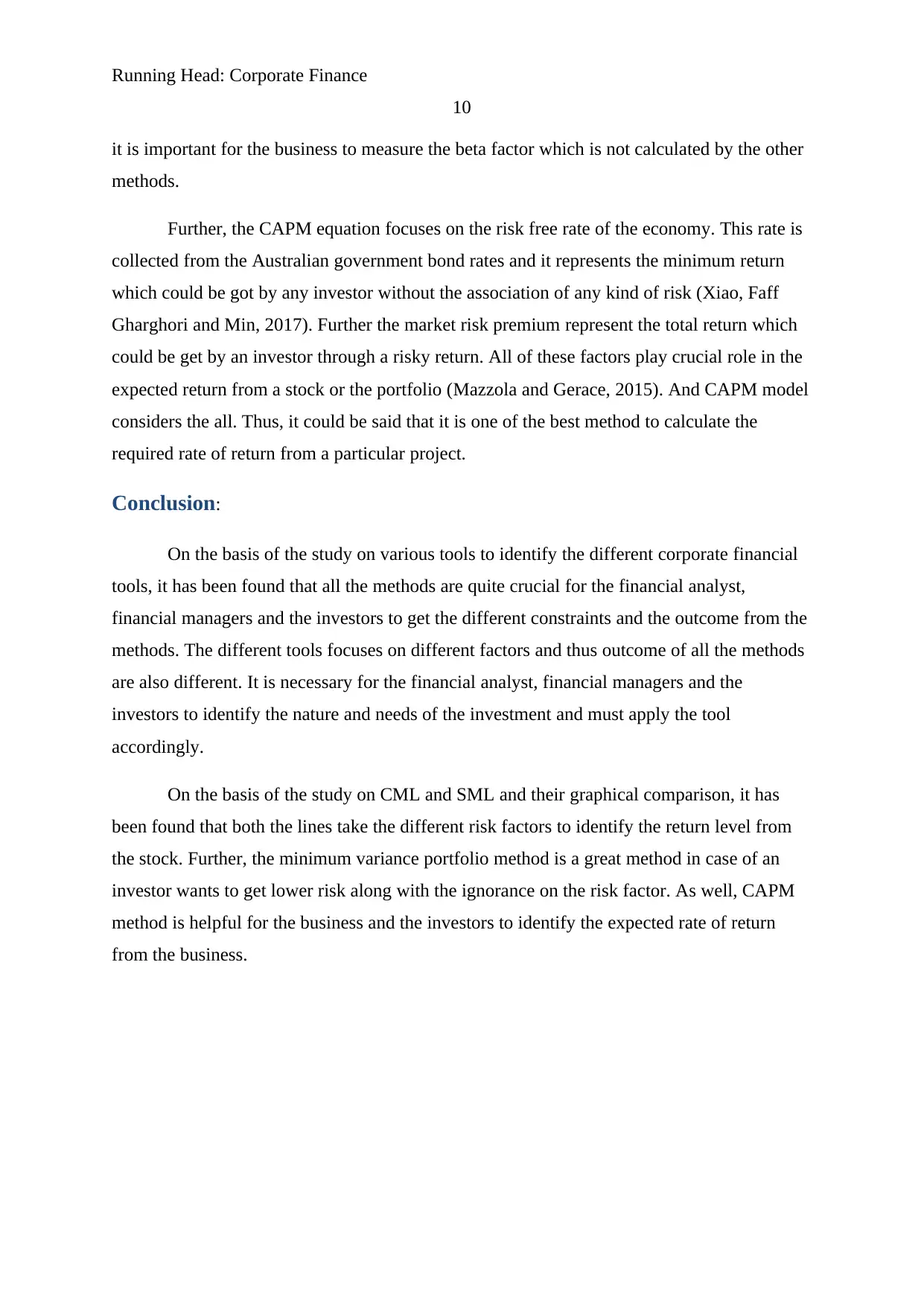
Running Head: Corporate Finance
10
it is important for the business to measure the beta factor which is not calculated by the other
methods.
Further, the CAPM equation focuses on the risk free rate of the economy. This rate is
collected from the Australian government bond rates and it represents the minimum return
which could be got by any investor without the association of any kind of risk (Xiao, Faff
Gharghori and Min, 2017). Further the market risk premium represent the total return which
could be get by an investor through a risky return. All of these factors play crucial role in the
expected return from a stock or the portfolio (Mazzola and Gerace, 2015). And CAPM model
considers the all. Thus, it could be said that it is one of the best method to calculate the
required rate of return from a particular project.
Conclusion:
On the basis of the study on various tools to identify the different corporate financial
tools, it has been found that all the methods are quite crucial for the financial analyst,
financial managers and the investors to get the different constraints and the outcome from the
methods. The different tools focuses on different factors and thus outcome of all the methods
are also different. It is necessary for the financial analyst, financial managers and the
investors to identify the nature and needs of the investment and must apply the tool
accordingly.
On the basis of the study on CML and SML and their graphical comparison, it has
been found that both the lines take the different risk factors to identify the return level from
the stock. Further, the minimum variance portfolio method is a great method in case of an
investor wants to get lower risk along with the ignorance on the risk factor. As well, CAPM
method is helpful for the business and the investors to identify the expected rate of return
from the business.
10
it is important for the business to measure the beta factor which is not calculated by the other
methods.
Further, the CAPM equation focuses on the risk free rate of the economy. This rate is
collected from the Australian government bond rates and it represents the minimum return
which could be got by any investor without the association of any kind of risk (Xiao, Faff
Gharghori and Min, 2017). Further the market risk premium represent the total return which
could be get by an investor through a risky return. All of these factors play crucial role in the
expected return from a stock or the portfolio (Mazzola and Gerace, 2015). And CAPM model
considers the all. Thus, it could be said that it is one of the best method to calculate the
required rate of return from a particular project.
Conclusion:
On the basis of the study on various tools to identify the different corporate financial
tools, it has been found that all the methods are quite crucial for the financial analyst,
financial managers and the investors to get the different constraints and the outcome from the
methods. The different tools focuses on different factors and thus outcome of all the methods
are also different. It is necessary for the financial analyst, financial managers and the
investors to identify the nature and needs of the investment and must apply the tool
accordingly.
On the basis of the study on CML and SML and their graphical comparison, it has
been found that both the lines take the different risk factors to identify the return level from
the stock. Further, the minimum variance portfolio method is a great method in case of an
investor wants to get lower risk along with the ignorance on the risk factor. As well, CAPM
method is helpful for the business and the investors to identify the expected rate of return
from the business.
Paraphrase This Document
Need a fresh take? Get an instant paraphrase of this document with our AI Paraphraser
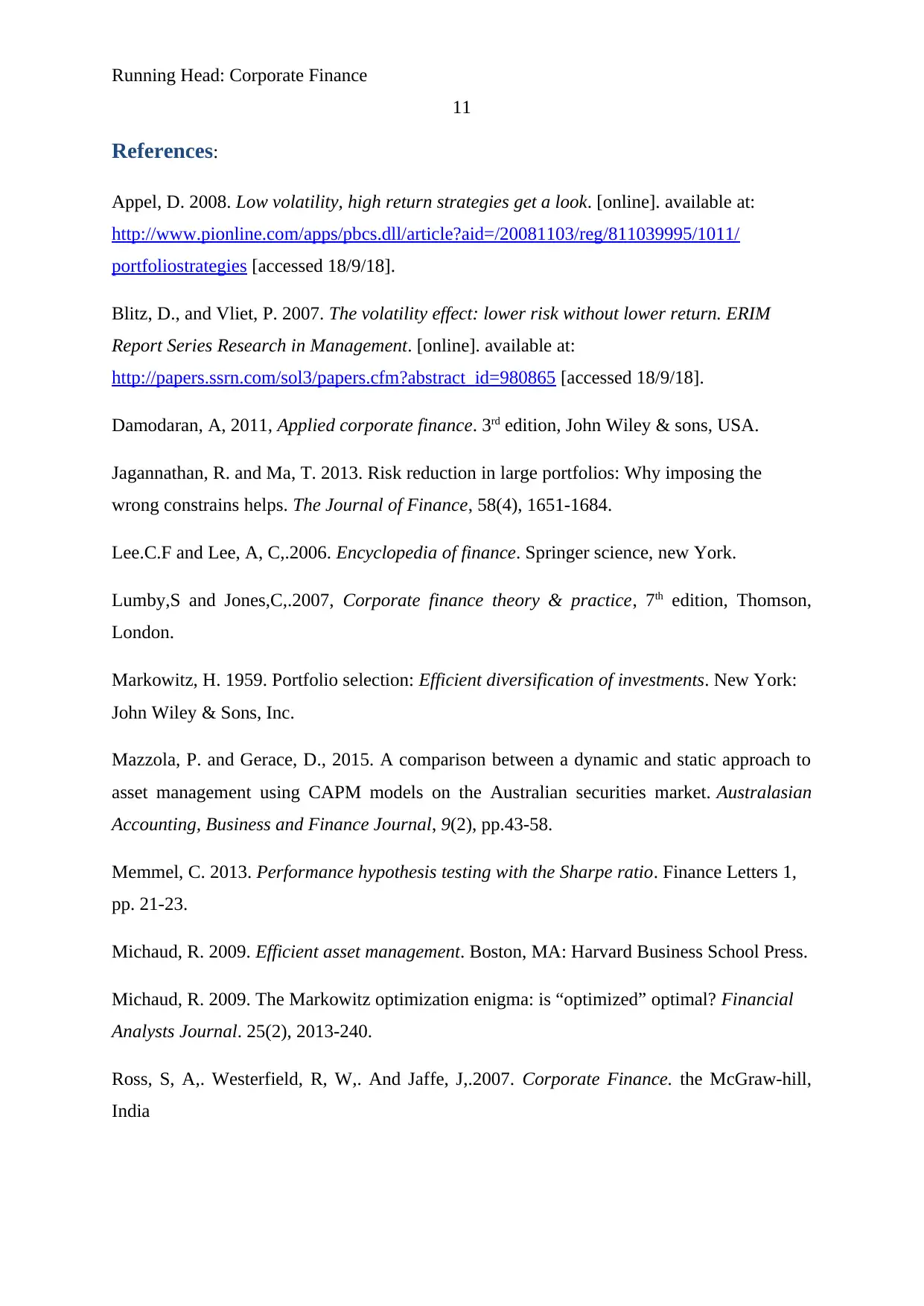
Running Head: Corporate Finance
11
References:
Appel, D. 2008. Low volatility, high return strategies get a look. [online]. available at:
http://www.pionline.com/apps/pbcs.dll/article?aid=/20081103/reg/811039995/1011/
portfoliostrategies [accessed 18/9/18].
Blitz, D., and Vliet, P. 2007. The volatility effect: lower risk without lower return. ERIM
Report Series Research in Management. [online]. available at:
http://papers.ssrn.com/sol3/papers.cfm?abstract_id=980865 [accessed 18/9/18].
Damodaran, A, 2011, Applied corporate finance. 3rd edition, John Wiley & sons, USA.
Jagannathan, R. and Ma, T. 2013. Risk reduction in large portfolios: Why imposing the
wrong constrains helps. The Journal of Finance, 58(4), 1651-1684.
Lee.C.F and Lee, A, C,.2006. Encyclopedia of finance. Springer science, new York.
Lumby,S and Jones,C,.2007, Corporate finance theory & practice, 7th edition, Thomson,
London.
Markowitz, H. 1959. Portfolio selection: Efficient diversification of investments. New York:
John Wiley & Sons, Inc.
Mazzola, P. and Gerace, D., 2015. A comparison between a dynamic and static approach to
asset management using CAPM models on the Australian securities market. Australasian
Accounting, Business and Finance Journal, 9(2), pp.43-58.
Memmel, C. 2013. Performance hypothesis testing with the Sharpe ratio. Finance Letters 1,
pp. 21-23.
Michaud, R. 2009. Efficient asset management. Boston, MA: Harvard Business School Press.
Michaud, R. 2009. The Markowitz optimization enigma: is “optimized” optimal? Financial
Analysts Journal. 25(2), 2013-240.
Ross, S, A,. Westerfield, R, W,. And Jaffe, J,.2007. Corporate Finance. the McGraw-hill,
India
11
References:
Appel, D. 2008. Low volatility, high return strategies get a look. [online]. available at:
http://www.pionline.com/apps/pbcs.dll/article?aid=/20081103/reg/811039995/1011/
portfoliostrategies [accessed 18/9/18].
Blitz, D., and Vliet, P. 2007. The volatility effect: lower risk without lower return. ERIM
Report Series Research in Management. [online]. available at:
http://papers.ssrn.com/sol3/papers.cfm?abstract_id=980865 [accessed 18/9/18].
Damodaran, A, 2011, Applied corporate finance. 3rd edition, John Wiley & sons, USA.
Jagannathan, R. and Ma, T. 2013. Risk reduction in large portfolios: Why imposing the
wrong constrains helps. The Journal of Finance, 58(4), 1651-1684.
Lee.C.F and Lee, A, C,.2006. Encyclopedia of finance. Springer science, new York.
Lumby,S and Jones,C,.2007, Corporate finance theory & practice, 7th edition, Thomson,
London.
Markowitz, H. 1959. Portfolio selection: Efficient diversification of investments. New York:
John Wiley & Sons, Inc.
Mazzola, P. and Gerace, D., 2015. A comparison between a dynamic and static approach to
asset management using CAPM models on the Australian securities market. Australasian
Accounting, Business and Finance Journal, 9(2), pp.43-58.
Memmel, C. 2013. Performance hypothesis testing with the Sharpe ratio. Finance Letters 1,
pp. 21-23.
Michaud, R. 2009. Efficient asset management. Boston, MA: Harvard Business School Press.
Michaud, R. 2009. The Markowitz optimization enigma: is “optimized” optimal? Financial
Analysts Journal. 25(2), 2013-240.
Ross, S, A,. Westerfield, R, W,. And Jaffe, J,.2007. Corporate Finance. the McGraw-hill,
India
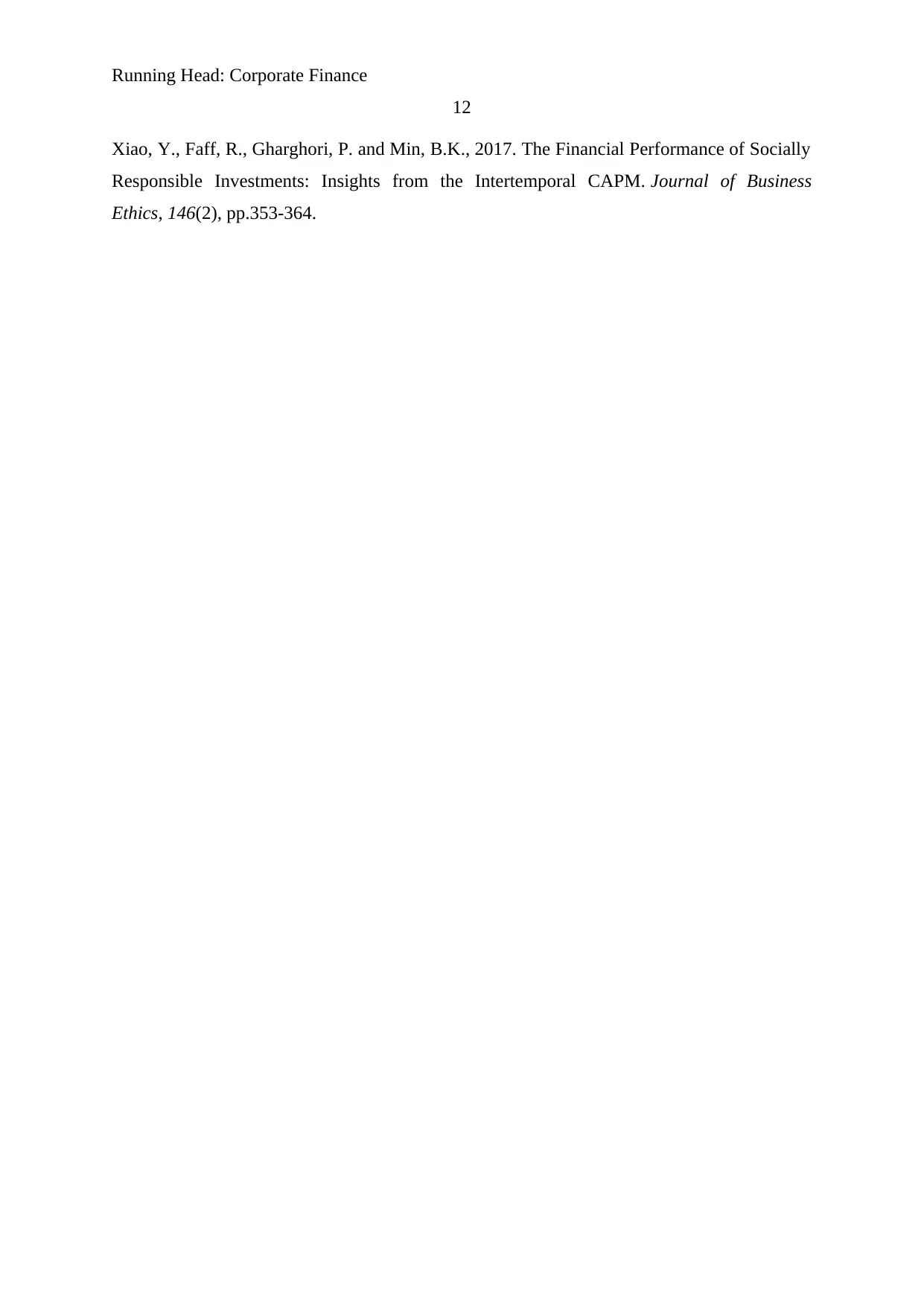
Running Head: Corporate Finance
12
Xiao, Y., Faff, R., Gharghori, P. and Min, B.K., 2017. The Financial Performance of Socially
Responsible Investments: Insights from the Intertemporal CAPM. Journal of Business
Ethics, 146(2), pp.353-364.
12
Xiao, Y., Faff, R., Gharghori, P. and Min, B.K., 2017. The Financial Performance of Socially
Responsible Investments: Insights from the Intertemporal CAPM. Journal of Business
Ethics, 146(2), pp.353-364.
⊘ This is a preview!⊘
Do you want full access?
Subscribe today to unlock all pages.

Trusted by 1+ million students worldwide
1 out of 12
Related Documents
Your All-in-One AI-Powered Toolkit for Academic Success.
+13062052269
info@desklib.com
Available 24*7 on WhatsApp / Email
![[object Object]](/_next/static/media/star-bottom.7253800d.svg)
Unlock your academic potential
© 2024 | Zucol Services PVT LTD | All rights reserved.



